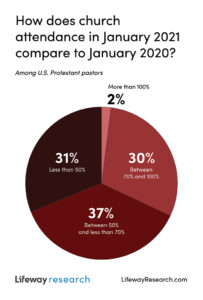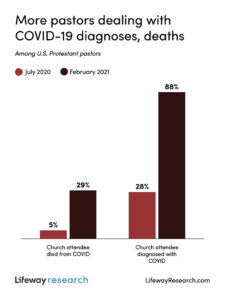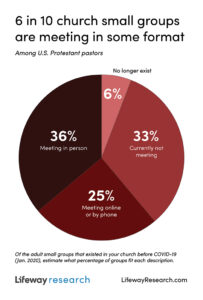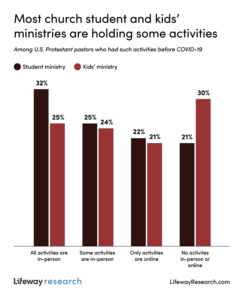By Aaron Earls
LifeWay news office
 NASHVILLE — Most churches have found a way to continue meeting despite the ongoing pandemic, but statistics from January revealed that — as COVID-19 cases spiked across the country — many churches elected not to meet in person during the month.
NASHVILLE — Most churches have found a way to continue meeting despite the ongoing pandemic, but statistics from January revealed that — as COVID-19 cases spiked across the country — many churches elected not to meet in person during the month.
A new study from Nashville based LifeWay Research found 76 percent of U.S. Protestant pastors say their churches met in person in January, down from 87 percent who said the same in September.
Even among those who are holding in-person services, few are near pre-pandemic attendance levels. Around 3 in 10 pastors (31 percent) say their attendance in January 2021 is less than half what it was in January 2020, months before the coronavirus prompted national lockdowns.
Slightly more (37 percent) note attendance between 50 percent and 70 percent. Another 3 in 10 say attendance is close to normal (70 percent-100 percent). Few (2 percent) have grown in their in-person attendance compared to one year ago.
“Churches continue to evaluate when to meet in person based on local conditions and cases within their congregation,” said Scott McConnell, executive director of LifeWay Research. “Even when a church determines it’s safe to meet, their individual members will return on their own timetable.”
Mainline pastors (39 percent) are more than three times as likely as evangelical pastors (12 percent) to say they did not meet in person in January.
COVID-19 challenges and opportunities
 Compared to last summer, the winter spike of COVID-19 cases brought more pastors face-to-face with the pandemic. Three times as many now say someone in their church has been diagnosed with COVID-19, and almost six times as many pastors report an attendee dying from it.
Compared to last summer, the winter spike of COVID-19 cases brought more pastors face-to-face with the pandemic. Three times as many now say someone in their church has been diagnosed with COVID-19, and almost six times as many pastors report an attendee dying from it.
Almost 9 in 10 Protestant pastors (88 percent) say a church attendee has been diagnosed with COVID-19, up from 28 percent in July 2020. Close to 3 in 10 (29 percent) say a member died from COVID-19, compared to 5 percent last summer.
Not surprisingly, pastors of churches with 200 or more in attendance are the most likely to say someone in their congregation died from COVID-19 (51 percent), while pastors of churches with fewer than 50 are the least likely (15 percent).
Younger pastors (18-44 years-old) are the most likely to have lost a church attendee to the coronavirus (41 percent), as well as pastors in the South (38 percent).
“The respect pastors in specific regions had last summer for the devastation of this pandemic has now spread throughout the nation,” said McConnell. “For a growing number, the loss of life has reached a dear saint or regular attendee in their own congregation.”
Much of the financial challenges remain the same. Similar numbers from July 2020 say an attendee lost their job (50 percent) and had income impacted by reduced work hours (72 percent) at any time during the coronavirus pandemic.
Despite those difficulties, pastors say the pandemic has provided opportunities for their church to serve others and even reach new people.
Almost all pastors (90 percent) say people in their church have helped each other with tangible needs during the pandemic, while almost three in four (73 percent) report attendees meeting tangible needs in the community connected to the pandemic.
Close to nine in 10 pastors (88 percent) say new people who have not attended their church in the past have attended or connected online during the pandemic. A quarter (25 percent) say an attendee has seen someone make a commitment to follow Christ after sharing the gospel.
Small group survival
 When asked to estimate what percentage of small groups or Sunday School classes that existed in their church before the pandemic are currently meeting, have stopped meeting temporarily, or no longer exist, pastors say most of their church’s small groups (62 percent) are still meeting in some way.
When asked to estimate what percentage of small groups or Sunday School classes that existed in their church before the pandemic are currently meeting, have stopped meeting temporarily, or no longer exist, pastors say most of their church’s small groups (62 percent) are still meeting in some way.
Pastors estimate more than a third of groups (36 percent) are meeting in person, while 25 percent are meeting online or by phone. Another third of church classes are not currently meeting, and 6 percent of classes no longer exist.
Mainline pastors (56 percent) are more than twice as likely as evangelical pastors (26 percent) to say none of their groups are meeting in person.
“Each group of adults faces the same questions as the church about when and how to meet,” said McConnell. “Technology has allowed a majority to meet in some form, but many are waiting or need help knowing how to restart.”
More than a third of pastors (38 percent) say none of their small groups are meeting in person. Around three in 10 (30 percent) say most of their groups are in-person.
Some churches have not been able to adapt to using technology to meet, as 41 percent of pastors say none of their groups are meeting online or by phone.
One in five pastors (20 percent) report having a small group end since the start of the pandemic. Fewer than 1 in 20 (four percent) say most of their groups no longer exist at all.
Among the pastors of churches where a majority of adult small groups are not meeting, there remains significant questions about when most groups will start meeting again. Only three percent believe that will happen this month. Nearly a quarter (22 percent) think sometime in March, April or May.
Others are looking for this summer (17 percent) or the fall (20 percent) before most groups will start back. More than a third (36 percent) say they are not sure when most groups will start to meet again.
Varied approach to student and kids’ ministries
Among churches that had student ministry activities prior to the pandemic, four in five are meeting in some way, and most are holding some in-person activities.
Around a third (32 percent) of pastors who had student ministries before the pandemic, say all of their student ministry activities now are meeting in person.
 A quarter (25 percent) say only some activities are in-person. Another 22 percent say the only activities currently happening are online. Slightly fewer (21 percent) say they aren’t holding any student activities in-person or online now.
A quarter (25 percent) say only some activities are in-person. Another 22 percent say the only activities currently happening are online. Slightly fewer (21 percent) say they aren’t holding any student activities in-person or online now.
Among those that are holding some in-person gatherings, more than three in four (77 percent) say their attendance is at least half what it was prior to the pandemic, including 5 percent who say they’ve grown.
For those that aren’t meeting at all or only online, more than a quarter (28 percent) expect to resume in-person student ministry activities by May. Others are aiming for this summer (18 percent), this fall (19 percent) or next year (four percent). Around three in 10 (31 percent) say they’re not sure when they’ll start meeting in person again.
Kids’ ministries are similarly divided in how they are approaching the pandemic and future planning, though pastors are more likely to say they aren’t having any kids’ activities.
Among pastors who say their church had kids’ ministry activities prior to the pandemic, 25 percent say all of their activities are in person, and another 24 percent say some events are in person. One in five (21 percent) say the only activities happening now are online, while 30 percent aren’t having any kids’ ministry activities currently.
For those that are hosting in-person kids’ activities, 71 percent say they have at least half of their pre-pandemic attendance, including two percent who say they have more now than they did prior to the pandemic.
Among the kid ministries not meeting at all or holding only online activities, 25 percent expect to resume in-person events by the end of spring, 17 percent say this summer, 26 percent are looking toward this fall, and one percent aim for 2022.
Three in 10 pastors are not sure when they’ll start back in-person kids’ ministry activities. B&R — The online survey of 430 Protestant pastors was conducted Feb. 1-11, 2021. Invitations were e-mailed to the LifeWay Research Pastor Panel followed by two reminders.
